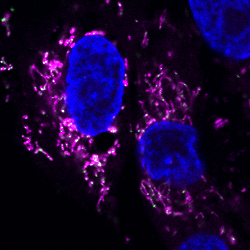Published on 20.09.2021
In medicine, some worlds do not meet. This is the case with mitochondrial diseases and interferonopathies. The former are genetic diseases causing a metabolic defect in mitochondria (cellular structures that produce the energy required for cell fonctions). Mitochondrial diseases mainly affect the nervous system and muscles. The latter are linked to an abnormal production of interferons (proteins that constitute the first immunological barrier against viral infections). They affect in particular the brain and the skin. In a new study published in the Journal of Experimental Medicine (JEM), the team led by Yanick Crow, director of the Neurogenetics and Neuroinflammation Laboratory at the Institut Imagine, has established a new link between these two classes of diseases in patients with mutations in a mitochondrial protein, including two patients with systemic scleroderma, a rare skin condition. This discovery echoes a burning question in the scientific community: what if these two families of diseases are partly related?
The permeabilisation of the mitochondria involved
This hypothesis is exciting because it offers a new angle in the understanding of these diseases. "This is a rapidly growing field of research", confirms Alice Lepelley, the first author of this study and an immunologist in Yanick Crow's team. As early as 2014, biologists from Yale University and the University of Melbourne established a fundamental link between mitochondrial damage and interferon production. In experiments carried out in vitro, they had shown that when mitochondria are stressed, they become permeable, allowing their nucleic acids (DNA or RNA) to escape into the cytoplasm. "The presence of these genetic sequences in the wrong place leads to an inappropriate activation of the antiviral response and production of type 1 interferon," explains the researcher. Indeed, the receptors usually responsible for identifying the presence of microbial nucleic acids (RNA or viral DNA) consider these mitochondrial nucleic acids as foreign, generating an abnormal immune response.
However, we had to wait until 2018 to confirm the validity of this potentially deleterious mechanism in patients. This discovery was decribed in the journal Nature, co-authored by Agnès Rötig, director of the mitochondrial disease genetics laboratory at Institut Imagine, Arnold Munnich, current president of the Imagine Foundation, and Yanick Crow. The researchers showed that a mitochondrial disease linked to a mutation in the PNPT1 gene causes RNA to be released from the mitochondria. As a result, patients produce a very large amount of type 1 interferons, which can trigger uncontrolled inflammation. Therefore this disease, originally considered a mitochondrial disease, could also be seen as an interferonopathy!
When released mitochondrial DNA ignate inflammation
In this new study published in JEM, two patients were followed in the rheumatology departments of the Hôpital Necker-Enfants Malades, in Paris, and the University Hospital of Leuven (Belgium) for systemic scleroderma, a rare skin disease associated with abnormal production of interferons and linked to autoimmunity. When this happens, the body triggers an immune response followed by inflammation directed against its own cells. Blood analysis confirmed an abnormal induction of type 1 interferon in these patients," says Alice Lepelley. Unexpectedly, genome sequencing in two patients also revealed the presence of variants in the ATAD3A gene, which have been associated with mitochondrial disease since 2016. Researchers needed no less to see the clinical potential of such a discovery and investigate further the mechanism at work.
They therefore identified other patients with mutations in the ATAD3A gene, who also showed overactivation of the interferon signalling pathway in blood. They then cultured skin cells (fibroblasts) from the patients and tested them. As a result, they showed that genetic variants of the ATAD3A gene do cause the release of mitochondrial DNA into the cytoplasm, inducing the accumulation of type 1 interferons into the fibroblasts. "This is the first time that this mechanism has been demonstrated with mitochondrial DNA," says Alice Lepelley. "These new clinical cases lead us to believe that associations between mitochondrial diseases and interferonopathies are probably more frequent than previously thought."


